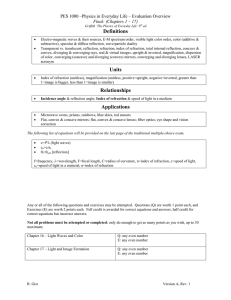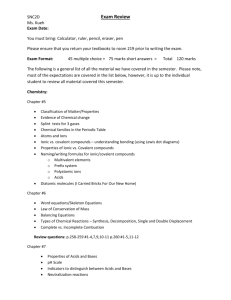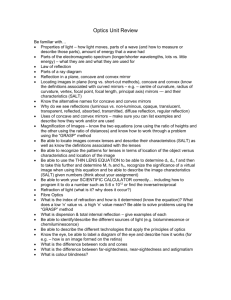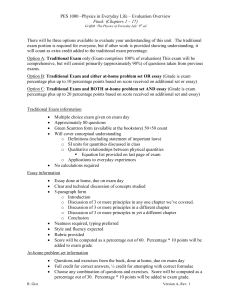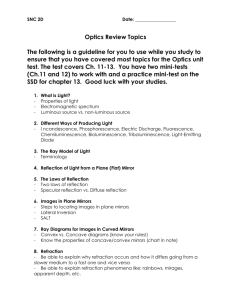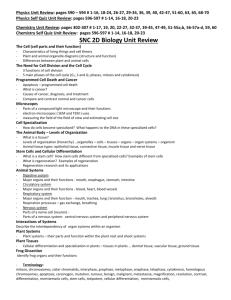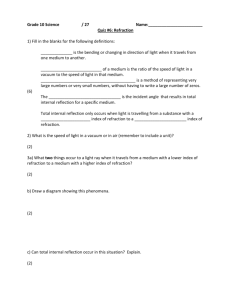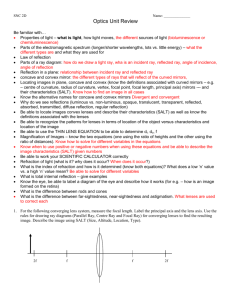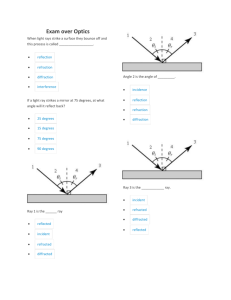File - Ms. Blake 802
advertisement
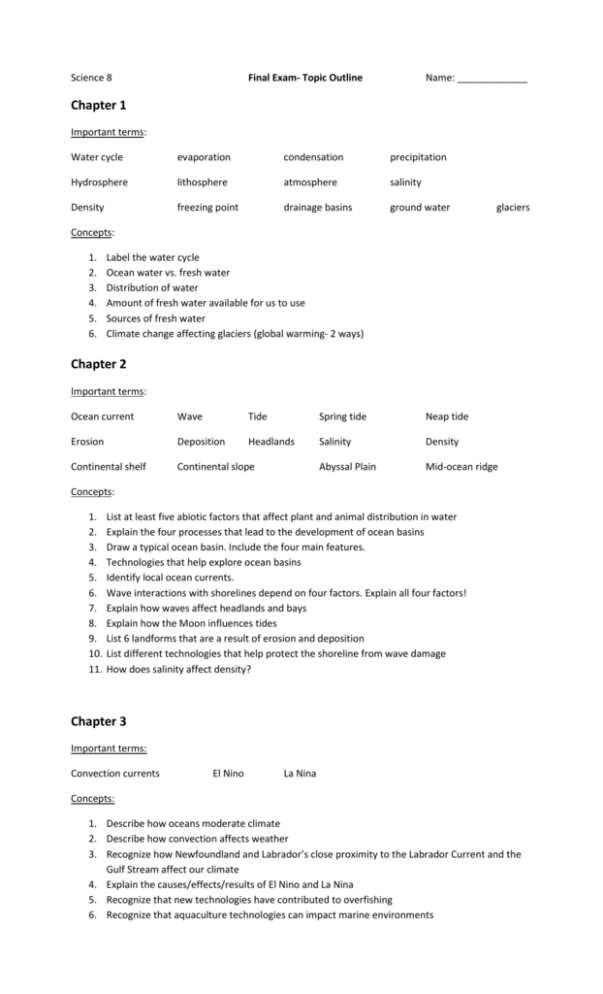
Science 8 Final Exam- Topic Outline Name: _____________ Chapter 1 Important terms: Water cycle evaporation condensation precipitation Hydrosphere lithosphere atmosphere salinity Density freezing point drainage basins ground water glaciers Concepts: 1. 2. 3. 4. 5. 6. Label the water cycle Ocean water vs. fresh water Distribution of water Amount of fresh water available for us to use Sources of fresh water Climate change affecting glaciers (global warming- 2 ways) Chapter 2 Important terms: Ocean current Wave Tide Spring tide Neap tide Erosion Deposition Headlands Salinity Density Continental shelf Continental slope Abyssal Plain Mid-ocean ridge Concepts: 1. 2. 3. 4. 5. 6. 7. 8. 9. 10. 11. List at least five abiotic factors that affect plant and animal distribution in water Explain the four processes that lead to the development of ocean basins Draw a typical ocean basin. Include the four main features. Technologies that help explore ocean basins Identify local ocean currents. Wave interactions with shorelines depend on four factors. Explain all four factors! Explain how waves affect headlands and bays Explain how the Moon influences tides List 6 landforms that are a result of erosion and deposition List different technologies that help protect the shoreline from wave damage How does salinity affect density? Chapter 3 Important terms: Convection currents El Nino La Nina Concepts: 1. Describe how oceans moderate climate 2. Describe how convection affects weather 3. Recognize how Newfoundland and Labrador’s close proximity to the Labrador Current and the Gulf Stream affect our climate 4. Explain the causes/effects/results of El Nino and La Nina 5. Recognize that new technologies have contributed to overfishing 6. Recognize that aquaculture technologies can impact marine environments Chapter 7 Important terms: Fluids Viscosity Flow rate Particle Theory of Matter Important concepts: - - Compare solids, liquids, and gases using the particle theory of matter o Shape o Volume o Particle arrangement o Particle movement Identify examples of fluids in everyday life Explain the relationship between velocity and friction Identify examples of viscosity in everyday life Identify examples of liquids with different flow rates Compare the viscosity of various liquids What are some factors that can modify the viscosity of a liquid? Explain a liquid’s resistance to flow in terms of the particle theory of matter o Strength of attraction between particles o Temperature o Concentration Chapter 8 Important terms: Mass Volume Density Important concepts: - Explain how the particle theory of matter relates to density (spaces) Describe the relationship between state of matter and density (refer to chart in notes) Calculate the density, mass, and volume of various substances Identify examples of density changes in everyday life Identify examples where the density of a substance changes naturally CORE LAB Chapter 9 Important terms: Force Newton Balanced force Unbalanced force Weight Mass buoyancy Average density swim bladder Pressure Pascal Atmospheric pressure Pneumatic system Hydraulic system Pascal’s Law Important concepts: - Explain the difference between weight and mass Explain why an object sinks/floats What are some technologies that have been developed because of our understanding of density and buoyancy? List examples of materials that may sink or float Calculate pressure, force, and area Explain the relationship among pressure, volume, and temperature when liquids and gases are heated or compressed Unit 3- Chapters 4-6 Important terms light specular diffuse refraction rectilinear propagation frequency spectrum wavelength trough crest electromagnetic visible light spectrum incident light ray normal reflected light ray angle of incidence angle of reflection specular reflection diffuse reflection plane mirror concave mirror convex mirror law of reflection focal point principal axis refraction angle of refraction refracted ray lens concave lens convex lens near-sightedness far-sightedness Important concepts 1. Provide examples of ideas and theories of light: a. Pythagoras b. Galileo c. Michelson 2. Speed of light 3. Compare the speed of light to the speed of sound 4. Early technologies that involved light: a. Microscope b. Telescope 5. Describe the relationship between frequency and wavelength 6. Describe the electromagnetic spectrum in terms of wavelength, frequency, and energy 7. Provide examples of the use of each type of electromagnetic radiation 8. State positive and negative effects of the following: a. Radio waves b. X-rays c. Ultraviolet d. Gamma rays 9. State the properties of visible light 10. List the constituent colours of white light in order of degree of refraction 11. Relate the amount of refraction for each colour to its wavelength. Include: a. Red b. Violet 12. Provide examples of each type of mirror: a. Plane b. Concave c. Convex 13. Construct ray diagrams for the following mirrors: a. plane b. concave c. convex 14. List the SPOT characteristics for each ray diagram 15. Differentiate between real and virtual images 16. Law of Reflection Lab 17. Refraction Lab 18. Measure angles of incidence, reflection, and refraction 19. Provide examples of each type of lens- concave and convex 20. Describe how the different lenses refract light 21. Describe how lenses correct near-sightedness and far-sightedness Chapter 10 Important terms cell cell theory cell wall cell membrane chloroplast cytoplasm nucleus vacuole mitochondria mitosis Important concepts Describe the four characteristics of living things Identify and label the major parts of the compound microscope: o Eyepiece, objective lenses, stage, coarse adjustment knob, fine adjustment knob, light source, iris diaphragm, base, barrel (tube), arm, revolving nosepiece Label the organelles of plant and animal cells Describe the function of the organelles found in typical plant and animal cells Draw a typical plant and animal cell List three differences between plant and animal cells Chapter 11 Important terms Tissue organ organ system Important concepts Describe the levels of organization Recognize that cells and organisms require the same basic necessities of life: oxygen, nutrients, waste removal Identify the main function and organs of the following systems: o Circulatory o Digestive o Respiratory o Excretory o Muscular o Nervous Chapter 12 Explain the roles that diet, nutrition, stress and exercise can have on the human body (worksheet) Brief description of the following: o Insulin pump o Artificial heart Describe the different connections between systems o Circulatory and Respiratory o Circulatory and Digestive o Nervous and Muscular The Effect of Activity on Heart Rate and Breathing Rate (Lab) What is cellular respiration? Describe
